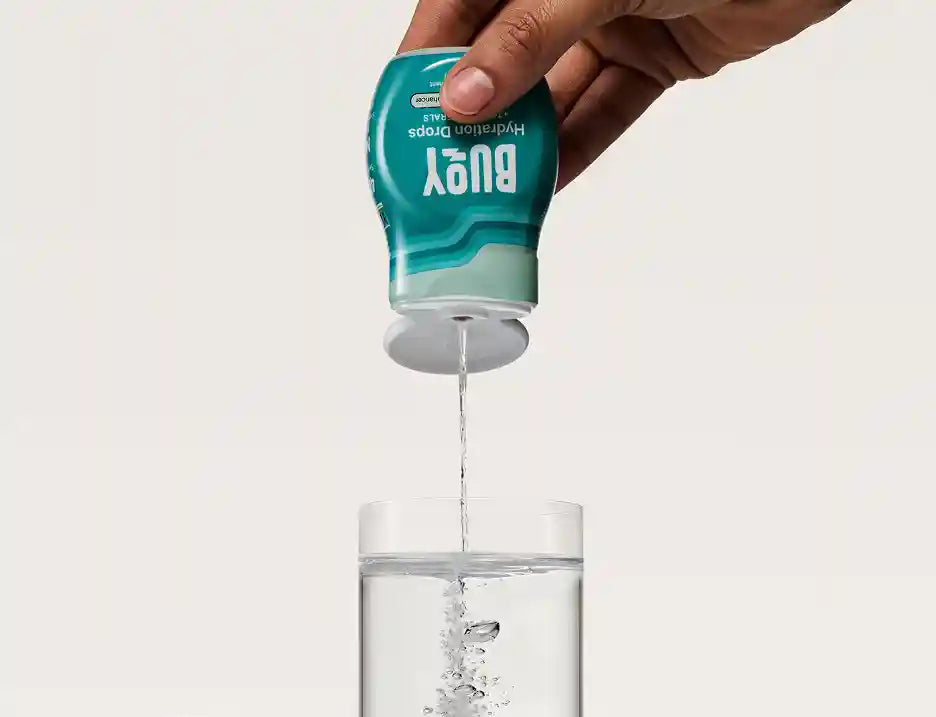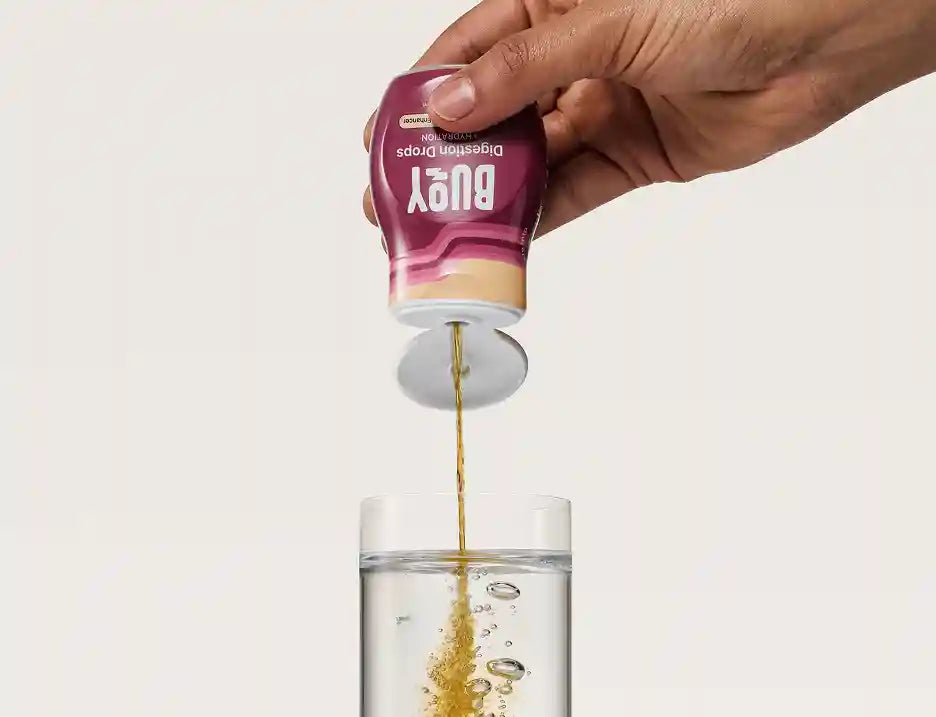
What Causes Electrolyte Imbalance? Everything You Need To Know
Electrolyte imbalance happens when levels of key minerals in your blood, like sodium and potassium, are either too high or too low. This can affect how you feel day to day, from mild symptoms like tiredness and muscle cramps to more serious problems such as confusion or irregular heartbeat (1).
Have you ever felt muscle cramps after an intense workout or experienced fatigue without a clear cause? While multiple factors could be at play, one often-overlooked culprit might be an electrolyte imbalance. These charged minerals play a critical role in regulating numerous bodily functions, and when they're out of balance, the ramifications can be far-reaching.
Essential Takeaways:
- Electrolyte imbalances can impact everything from your energy levels to muscle function. Understanding the causes is key to prevention and treatment.
- Hydration Drops offer an easy, effective way to maintain your electrolyte balance. Adding them to your daily routine can be a game-changer for your overall health and well-being.
In this guide, we'll explore the causes of electrolyte imbalance and provide actionable steps to manage it effectively.
- What Causes Electrolyte Imbalance?
- What Is Electrolyte Imbalance?
- Understanding Different Electrolytes and Their Functions
- Signs and Symptoms of Electrolyte Imbalance
- Common Factors that Trigger Electrolyte Imbalance
- Strategies to Prevent and Manage Electrolyte Imbalance
- When To Talk To A Doctor About Electrolyte Imbalance
- Introducing Buoy: Your Ally in Maintaining Electrolyte Balance
- Closing Thoughts
What Causes Electrolyte Imbalance?
Electrolytes are essential for a multitude of physiological processes in the human body. These charged minerals—such as sodium, potassium, calcium, and magnesium—play an integral role in everything from muscle contractions and nerve impulses to regulating your body's fluid balance and pH levels. Their significance in maintaining optimal bodily functions cannot be overstated.
However, achieving the perfect balance of these minerals is easier said than done. An imbalance in electrolyte levels can trigger a range of health problems. These can vary from minor issues like fatigue and muscle cramps to more serious conditions, such as irregular heart rhythms and seizures (1).
What Is Electrolyte Imbalance?
Electrolyte imbalance happens when levels of one or more key minerals in your body are outside the normal range. That can mean levels are too high or too low. Sodium, potassium, calcium, and magnesium are some of the main electrolytes that help regulate muscle contractions, nerve signals, fluid balance, and pH in the blood (1). When these levels shift too far in either direction, the systems that rely on them do not work as smoothly.
Some imbalances are mild and cause only vague symptoms, such as low energy or occasional muscle cramps. Others can be more serious and may lead to confusion, weakness, irregular heartbeat, or even seizures in extreme cases (1). Because different electrolytes affect different functions, the exact symptoms depend on which mineral is out of balance and how severe the change is.
Understanding Different Electrolytes and Their Functions
Electrolytes are far more than an ingredient in sports drinks. These essential minerals have specific and important roles in the body. Let's briefly explore some of the primary electrolytes and what they do:
- Sodium: Regulates fluid balance and is vital for muscle and nerve function (2).
- Potassium: Helps regulate heart function, muscle contractions, and nerve signals (3).
- Calcium: Essential for bone health, muscle contractions, nerve signaling, and blood clotting. An imbalance can impact cardiac and neurological functions (4).
- Magnesium: Supports muscle contractions, nerve function, and energy production (5).
While these are just a few of the electrolytes your body relies on, an imbalance in just one can throw off your body's internal equilibrium, affecting your daily health and well-being.
Signs and Symptoms of Electrolyte Imbalance
Electrolyte imbalances can show up in different ways depending on which minerals are involved and how large the shift is. Mild changes can be easy to miss, while more serious changes tend to produce clearer symptoms. Paying attention to early signs can help you seek support before a small issue becomes a bigger problem.
Some common signs and symptoms people may notice include:
- muscle cramps, twitching, or weakness
- feeling more tired than usual or low on energy
- headaches or difficulty concentrating
- changes in heartbeat that feel fast, slow, or irregular
- feeling dizzy, lightheaded, or faint
- nausea, vomiting, or changes in appetite
- confusion, irritability, or changes in mood (1)
These symptoms can also be caused by many other health issues, so they do not automatically mean you have an electrolyte imbalance. They do, however, signal that something in the body may need attention. Severe symptoms such as chest pain, severe weakness, confusion, or trouble breathing should be treated as urgent and checked by a doctor right away.
Common Factors that Trigger Electrolyte Imbalance
Understanding the root causes of an electrolyte imbalance can empower you to manage it effectively. Here are some common factors.
Dietary Choices
A diet lacking essential minerals like sodium, potassium, and magnesium can contribute to imbalances. Overconsumption of certain electrolytes, usually sodium, is another concern (1).
Low intake over time can contribute to deficiencies, while very high intake, especially of sodium, can raise levels above the ideal range (1). The goal is balance, not cutting electrolytes out.
Fluid Intake
Drinking too little fluid can make electrolytes more concentrated in the blood, while drinking too much plain water in a short period can dilute them. Both extremes can cause imbalance (5). Dehydration is a common issue in hot weather, during illness, or with heavy exercise. Overhydration is less common, but can occur when large volumes of water are consumed without any electrolytes, especially during prolonged activity.
Medication Side Effects
Certain medications, including diuretics and some antibiotics, can alter your electrolyte levels. Always consult a healthcare provider when starting new medications to understand potential side effects (1).
Underlying Health Conditions
Medical issues like kidney diseases, hormonal imbalances, or chronic illnesses can significantly disrupt your body's electrolyte equilibrium (7).
Physical Activity
Strenuous exercise, especially in hot and humid conditions, can cause significant loss of electrolytes through sweat. Without adequate replenishment, this can quickly lead to imbalance. Long runs, high intensity workouts, outdoor sports in the heat, and heavy physical jobs are all examples of situations where sweat losses may be high and electrolyte replacement becomes more important (7)(8).
Modern Farming and Water Processing Methods
The mineral content of food and water can vary depending on soil, farming practices, and local water treatment. Some research suggests that levels of certain minerals in produce have changed over time (8). The mineral content of tap water and bottled water is also highly variable (9). This means that even a generally healthy diet may not always provide the same mix of electrolytes for everyone.
For people who sweat heavily, train often, or live in hot climates, using products like Buoy can be a simple way to support electrolyte intake alongside a balanced diet.
This keeps the core idea but tones down the “modern depletion” angle and keeps it aligned with your references.

Strategies to Prevent and Manage Electrolyte Imbalance
So, how do you fix an electrolyte imbalance? The first step is prevention, and here are some strategies:
Eat a Balanced Diet
Incorporate foods rich in essential electrolytes like sodium, potassium, and magnesium. Fruits, vegetables, and lean proteins are good places to start (1). For more guidance on foods high in electrolytes, check out our blog post, Top 10 Foods High in Electrolytes and Why You Need Them.
Stay Hydrated
Maintain appropriate hydration levels based on your physical activity and climate. Make it a habit to drink water throughout the day, especially before and after physical activities, to prevent dehydration-related imbalances (6).
If you are losing a lot of fluid through sweat, vomiting, or diarrhea, it can help to replace both water and electrolytes together instead of drinking water alone (1)(5)(7). Small, regular sips are often easier for the body to handle than large amounts all at once.
Supplement Wisely
Sometimes, diet and water alone aren’t enough, especially if you lead an active lifestyle. Electrolyte supplements like Buoy drops can be a valuable asset. Supplements should support a balanced diet, not replace it. If you have kidney disease, heart problems, or take medicines that affect fluid or mineral balance, talk to your doctor before making big changes.
Limit Alcohol and Caffeine
Both alcohol and caffeine have diuretic properties, which means they can increase urine production and lead to faster loss of fluids from the body.
This accelerated fluid loss can deplete essential electrolytes, disrupting their balanced levels and potentially leading to an imbalance. Reducing your intake of these substances can help you maintain a more stable electrolyte profile (6).
Monitor Medications
If you're on medications that can affect electrolyte balance, such as diuretics, consult your healthcare provider for advice on management and potential adjustment.
Consult a Doctor
For severe or persistent imbalances, medical advice and intervention may be necessary.
By implementing these strategies, you can effectively maintain balanced electrolyte levels, positively contributing to your overall health.
When To Talk To A Doctor About Electrolyte Imbalance
Many mild electrolyte shifts can be managed with simple changes in diet, hydration, and lifestyle. It is still important to know when professional help is needed. Some imbalances can be linked to underlying health conditions, such as kidney disease or hormone problems, and may require medical treatment (1)(6)(7).
You should talk to a doctor if:
- symptoms are severe, such as chest pain, severe weakness, confusion, or trouble breathing
- cramps, fatigue, or dizziness are frequent and do not improve with better hydration and diet
- you have a medical condition that affects your kidneys, heart, or hormones
- you take medications known to affect fluid or electrolyte balance, such as diuretics
- you have had abnormal blood tests for sodium, potassium, calcium, or magnesium
A healthcare professional can perform blood tests, review medications, and suggest safe ways to correct any imbalance. Supplements like electrolyte drops can fit into that plan, but they should sit alongside medical advice for more complex cases.
Introducing Buoy: Your Ally in Maintaining Electrolyte Balance
Sometimes, life gets too busy to micromanage your electrolyte intake through diet alone. That's where Buoy steps in to offer a convenient solution. With products like Buoy Hydration Drops, Buoy Energy Drops, and Buoy Immunity Drops, keeping your electrolytes balanced has never been easier.
Whether you're a busy professional, an athlete, or someone who just wants to maintain a balanced life, Buoy offers an easy-to-use, all-in-one solution.
Shop Buoy’s collection of hydrating wellness drops now.
Closing Thoughts
Though it’s a common condition, electrolyte imbalance can lead to severe health issues if left unchecked. Recognizing the signs and taking preventive measures is important to maintain your health and vitality.
With the support of products like Buoy, maintaining this balance becomes hassle-free. Prioritize your health, and let's make electrolyte imbalance a worry of the past!
FAQs
What is electrolyte imbalance?
Electrolyte imbalance means levels of important minerals like sodium, potassium, calcium, and magnesium in your blood are outside the normal range (1). These minerals help regulate muscle contractions, nerve signals, and fluid balance. When they are too high or too low, you might notice symptoms such as tiredness, cramps, headaches, or changes in heartbeat. Some imbalances are mild and caused by things like dehydration. Others can be more serious and may be linked to illness or certain medicines.
What causes electrolyte imbalance?
Several factors can lead to electrolyte imbalance. Common causes include dehydration, drinking large amounts of water without electrolytes, heavy sweating, vomiting, diarrhea, and certain medications such as diuretics (1)(5)(7). Kidney disease, hormone disorders, and other chronic conditions can also affect how the body handles minerals. Diet plays a role too. Very low intake of key minerals or very high intake of sodium can shift levels over time. Often, more than one factor is involved.
What are the symptoms of electrolyte imbalance?
Symptoms can vary widely. Mild imbalances might cause vague signs such as low energy, headaches, or occasional muscle cramps. More noticeable symptoms can include muscle weakness, twitching, dizziness, nausea, or changes in heartbeat (1)(4)(5). In more severe cases, people may feel confused, very unwell, or short of breath. Because these symptoms overlap with many other health issues, it is a good idea to speak with a doctor if they are frequent, severe, or new for you.
Can dehydration cause electrolyte imbalance?
Yes. When you lose fluid through sweat, illness, or simply not drinking enough, electrolytes become more concentrated in the blood. Over time, this can lead to imbalance, especially if you are also losing electrolytes in sweat, vomit, or diarrhea (5)(7). On the other hand, drinking very large amounts of plain water in a short time without any electrolytes can dilute these minerals. The goal is to replace fluid in a steady way and, when losses are high, include electrolytes too.
How can I help prevent electrolyte imbalance?
You can support healthy electrolyte balance by eating a varied diet with fruits, vegetables, whole grains, and other sources of minerals, drinking fluids regularly, and adjusting intake when you sweat more or are ill (1)(5). For people who are very active, live in hot climates, or often lose fluid through exercise or travel, adding an electrolyte product such as Buoy Hydration Drops to drinks can be a simple way to support intake. If you have health conditions or take medicines that affect fluid or minerals, ask your doctor what is safe for you.
References:
- Healthline. (2019). Electrolytes: Functions, Imbalance, and Sources. Retrieved from https://www.healthline.com/nutrition/electrolytes
- Healthline. (2022). Potassium. Retrieved from https://www.healthline.com/health/potassium
- Medical News Today. (2020). Benefits and Sources of Calcium. Retrieved from https://www.medicalnewstoday.com/articles/248958
- Medical News Today. (2020). Why Do We Need Magnesium? Retrieved from https://www.medicalnewstoday.com/articles/2868396
- Popkin, B. M., D'Anci, K. E., & Rosenberg, I. H. (2010). Water, Hydration, and Health. Nutrition Reviews, 68(8), 439–458. Retrieved from https://www.ncbi.nlm.nih.gov/pmc/articles/PMC2908954/
- Koeppen, B. M. (2009). The Kidney and Acid-Base Regulation. Advances in Physiology Education, 33(4), 275–281. Retrieved from https://journals.physiology.org/doi/full/10.1152/advan.00054.2009
- Shirreffs, S.M., et al. (2004). Fluid and Electrolyte Needs for Preparation and Recovery from Training and Competition. Journal of Sports Sciences, 22(1), pp. 57–63. Retrieved from https://www.tandfonline.com/doi/abs/10.1080/0264041031000140572
- Davis, D. R., Epp, M. D., & Riordan, H. D. (2004). Changes in USDA Food Composition Data for 43 Garden Crops, 1950 to 1999. Journal of the American College of Nutrition, 23(6), 669-682. Retrieved from https://www.tandfonline.com/doi/abs/10.1080/07315724.2004.10719409
- Azoulay, A., Garzon, P., & Eisenberg, M.J. (2001). Comparison of the Mineral Content of Tap Water and Bottled Waters. Journal of General Internal Medicine, 16(3), 168-175. doi: 10.1111/j.1525-1497.2001.04189.x. Retrieved from https://www.ncbi.nlm.nih.gov/pmc/articles/PMC1495189/







